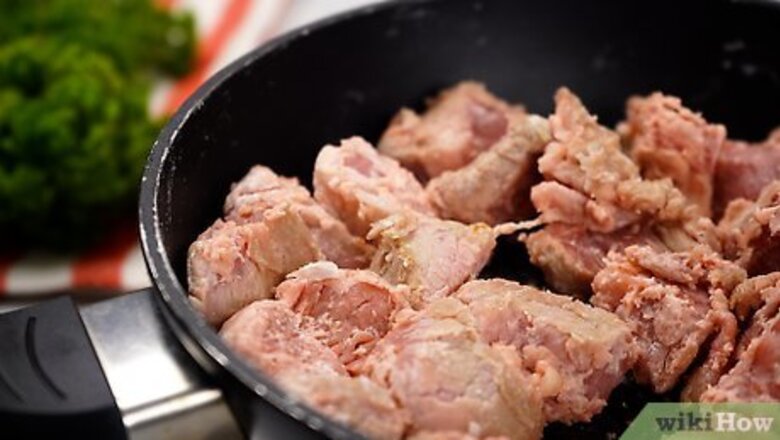
views
Making a Flour Roux to Thicken Stew
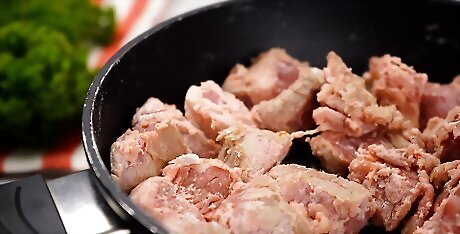
Brown (cover) the beef with flour before putting it in the stew. When browning the beef, first coat the meat in flour before adding to the braising liquid. This will not only help caramelize the meat for better flavor, but will also help thicken the stew later as the starch from the flour mixes with the liquid. Once you have browned the meat, deglaze the pot by adding red wine, beer or stock for extra flavor.
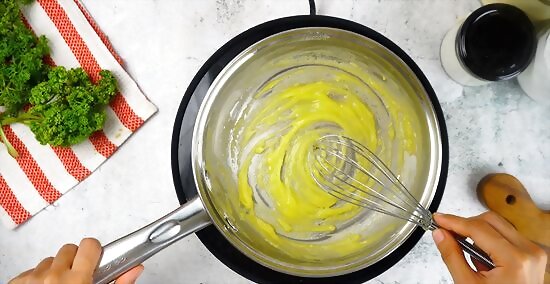
Mix flour with water to create the flour roux. This is one of the most common methods used to thicken beef stew. The primary protein in flour is gluten. When flour is mixed with water, the protein chains link end-to-end, which forms a web that thickens the sauce. To create the roux, reduce the heat on the stew and remove a quantity of the stewing liquid. Heat a quantity of fat (butter works best, generally about 2 tablespoons for a decent-sized stew) in a hot pan on medium heat, and add an equal quantity by weight of white flour, whisking the flour around to prevent it burning. Some recipes call for 6 tablespoons of flour and 4 tablespoons of butter or meat drippings to create the roux. You will end up with a whiteish-yellow paste which will melt at the edges and bubble. Keep stirring the paste around and let it darken slightly. The darker your roux, the more flavor it will add (flour gets nutty flavors as it cooks!) but the less thickening power it will have, so you want a pale roux.
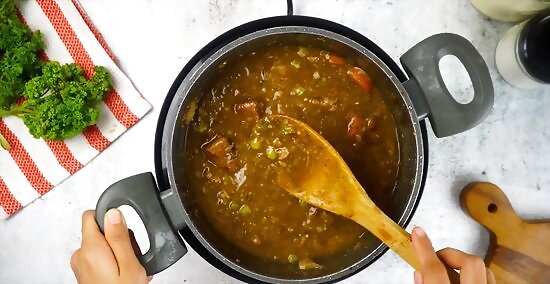
Add the roux to the stew. Once the paste has been thinned to the thickness of a very thick gravy, it can be stirred into your stew. It is important to cook the stew for another 5-10 minutes. This will ensure that the flour does not add a "raw" taste, but it should not be cooked much longer than that as the thickening power of the roux will be destroyed by prolonged cooking. Remember, the roux will reduce the intensity of the spices a bit so be sure to taste the stew to check the seasoning balance before you serve it. You could use milk instead of water to create the flour roux, although milk sticks and burns quite easily. Oatmeal or rice flour can be used instead of white flour.
Making Beurre Manié Flour Roux to Thicken Stew
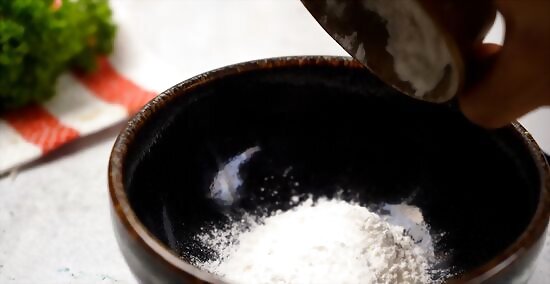
Take equal parts butter and flour. Knead them together. The butter should be slightly soft before combining it with the flour. For about 3 quarts of stew, use 2-3 tablespoons of butter and an equal amount of flour.
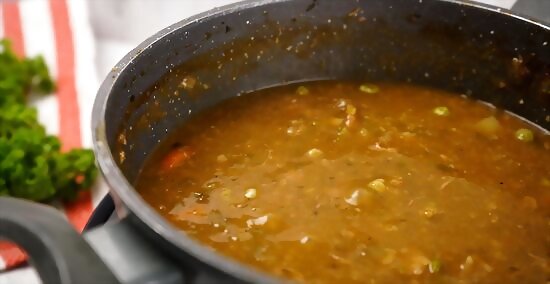
Immediately before serving, bring the liquid to a strong simmer.
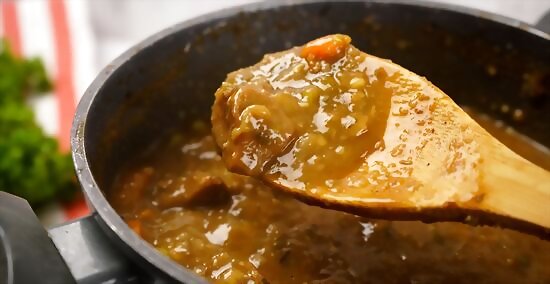
Whisk a small dob of the beurre manié into the stew. Return the liquid to a simmer, while whisking it constantly.
Using Starch or Other Ingredients to Thicken the Stew
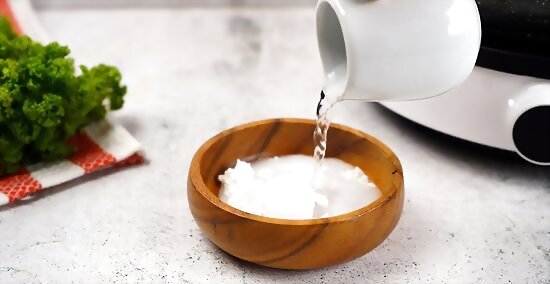
Add a dash of double cream or creme fraiche to make the stew smooth. Season as desired. You can also use potato, rice starch or tapioca. Mix about 2 teaspoons of any of these ingredients with a little water or milk, and then add these into the boiling stew, slowly while stirring. Potato starch gives a different kind of elasticity, more of the dessert kind. If none of the above options is available to you, try to add thickness by being creative. For example, you could try adding instant mashed potato powder, instant sauce mix, or even crushed crackers, although they are not ideal.
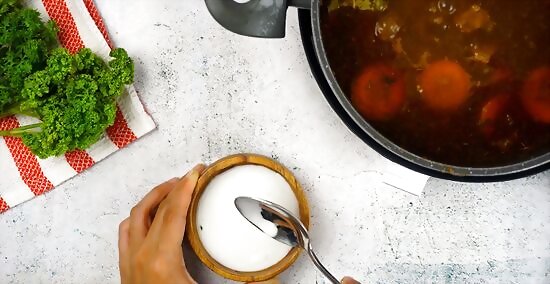
Use cornstarch to create the roux instead of flour. Take some of the stew broth and pour it into a medium mixing bowl. Let the broth cool if hot. Hot broth will cook the cornstarch before you have had time to mix it, and it will be a lumpy mess. Add a small amount (1 teaspoon to 1 tablespoon) of cornstarch to the broth. Mix it in until there are no lumps. A mixer works great here. When mixing is finished, pour back into the stew, and mix thoroughly. This is called a slurry. You could also use wine to create this. Turn up the heat, and keep stirring. This will help to prevent the mixture from clumping together. Cornstarch is similar to flour in its use as a thickening agent. Guar gum is another thickening agent that is used in industrial food processing to thicken sauces and such. If you can get your hands on it, use very little because it has 8 times the thickening effect that cornstarch has.
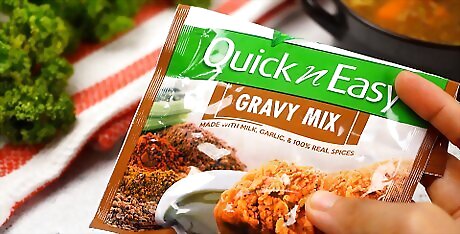
Try a packet of beef gravy mix. Combine the contents of the packet with a little water until smooth. Stir it in a bowl. A typical packet will thicken two cups of liquid to a gravy consistency and add a little more beefy flavor. Most packet gravies are cornstarch based, and mimic the effects of a slurry (cornstarch mixed with a little water until smooth).
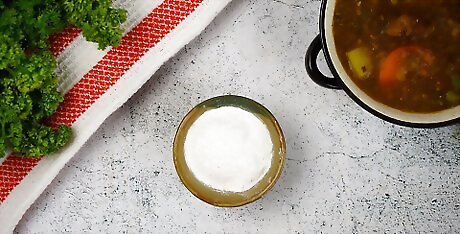
Choose a gluten free option. Arrowroot is a good gluten free option. If the stew is already prepared and is too thin, gradually stir in your arrowroot thickener, starting with about 1/2 teaspoon of thickener, and adding more to taste as the stew thickens. Remember, you must stir slowly and constantly at medium heat to thicken, so do not get impatient and add too much thickener at once. Arrowroot has more of a neutral flavor than cornstarch. It can also be used at varying temperatures without losing its ability to thicken foods. It tolerates acidic ingredients better than cornstarch and it can be cooked for a longer length of time.
Thickening Stew with Vegetables
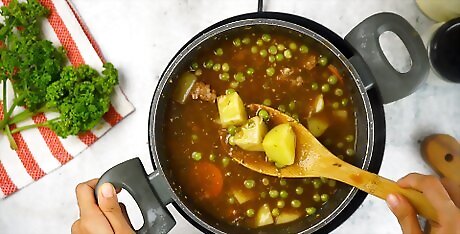
Choose a lot of meaty vegetables. Use more "meaty" vegetables that provide tasty filling, such as potatoes, carrots, celery, and cabbage. When they simmer or boil together with the stew, they will partially dissolve and give the surrounding sauce a richer texture. Root vegetables work well, especially potatoes. Cooking the potatoes with the stew naturally thickens it.
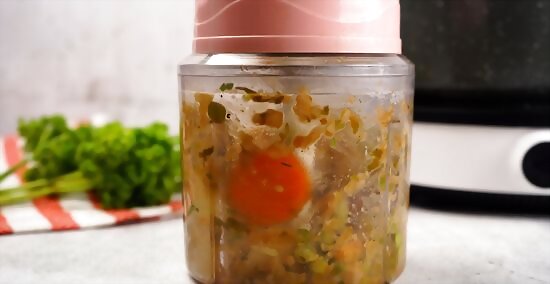
Turn vegetables into a paste. A simple method to thicken beef stew is to cook several whole vegetables in the stew pot, such as potatoes, carrots, onions and celery. After they have cooked and contributed to the overall stew flavor, they can be removed and blended into a paste with stock or some of the cooking liquid. Pull out some of the carrots and potatoes that you cooked with the stew, mash them with a potato masher or a fork, and stir the mashed vegetables back into the beef stew for a thicker consistency. You could also use an immersion blender directly in the stew to blend some of the vegetables in the broth to make a thicker stew. Stir this paste back into the stew to thicken it. This is a great way to improve the fiber content of a stew as well.
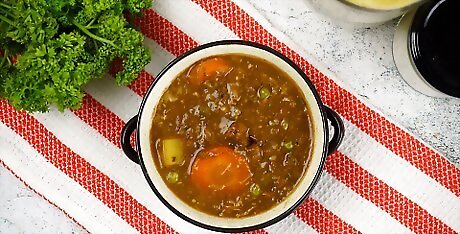
Finished.


















Comments
0 comment